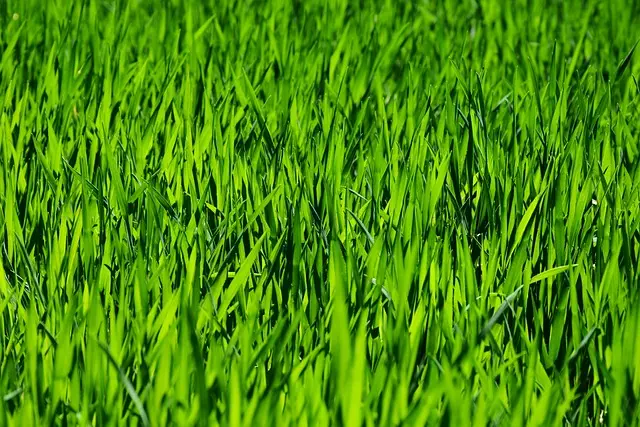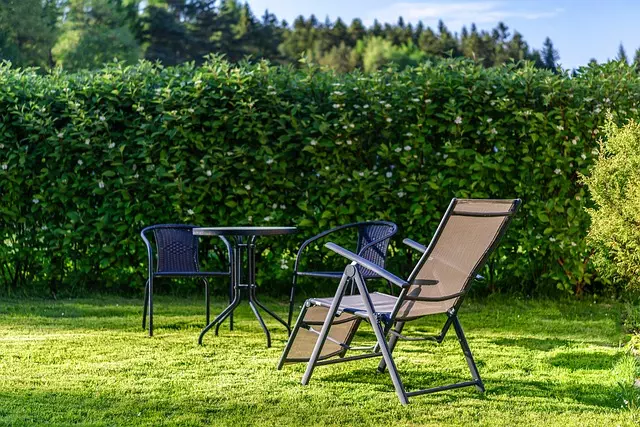Mulching is an essential aspect of lawn care that enhances turf health and aesthetics by retaining soil moisture, conserving water, and gradually enriching the soil with nutrients as it decomposes. This process also suppresses weeds, contributing to a cleaner and more uniform lawn appearance. Additionally, mulch can smartly edge garden beds, which not only improves curb appeal but also aligns with landscape design principles. Engaging in regular edging, whether manually or with powered equipment, is crucial for maintaining the sharp demarcation between the lawn and surrounding areas, which ensures efficient use of water and fertilizer, thereby supporting plant health and robust turfgrass growth. Lawn Care and Landscaping professionals recommend incorporating mulching and edging into a routine to achieve a well-maintained, visually appealing outdoor space that reflects a dedicated commitment to landscaping excellence.
Effective lawn care and landscaping hinge on practices that promote both aesthetic appeal and soil health. Among these, mulching and edging stand out as key techniques for maintaining a lush, well-defined lawn. This article delves into the multifaceted benefits of incorporating mulching into your routine, highlighting its role in retaining moisture, suppressing weeds, and enriching the soil. Additionally, mastering the art of edging is crucial for defining your lawn’s boundaries, enhancing curb appeal, and preventing grass encroachment onto pathways or flowerbeds. With a focus on choosing the right mulch type for your specific soil and climate, as well as detailed techniques for application, we guide you through the process of mulching to optimize lawn health. Furthermore, understanding how to edge strategically with precision and presentation will ensure your lawn’s edges are sharp and inviting. By combining these practices with an efficient mulching and edging routine, your lawn care and landscaping efforts will thrive year-round, creating a symbiotic relationship that supports both the visual aspects and the nutritional needs of your lawn.
- The Benefits of Integrating Mulching into Your Lawn Care Routine
- Mastering the Art of Edging for a Well-Defined Lawn Perimeter
The Benefits of Integrating Mulching into Your Lawn Care Routine

Incorporating mulching into your lawn care routine offers a multitude of benefits that can significantly enhance the health and appearance of your turf. Mulch, typically made from organic materials like leaves, grass clippings, or wood chips, serves as a protective layer over the soil. This layer helps to retain moisture, reducing the need for frequent watering and conserving water during periods of drought. The decomposition of mulch also enriches the soil with essential nutrients, acting as a slow-release fertilizer that supports grass growth and vitality. Additionally, mulching can suppress weeds by creating an unfavorable environment for their germination and growth, thus contributing to weed control in your lawn care regimen. Landscaping professionals often emphasize the aesthetic advantages of mulch, which can give your garden beds a tidy, finished look that complements the lush green of your well-maintained lawn. The visual harmony created by strategic mulching not only elevates the curb appeal but also enhances the overall landscaping design, making it a smart addition to any lawn care routine.
Mastering the Art of Edging for a Well-Defined Lawn Perimeter

Engaging in meticulous lawn care and landscaping practices, including mastering the art of edging, is crucial for maintaining a well-defined perimeter that accentuates the beauty of your lawn. Edging serves as a boundary between your grassy area and garden beds or sidewalks, delivering a clean, manicured look that elevates the overall aesthetic of your outdoor space. To achieve this, homeowners should regularly edge their lawns with a manual edger or an electric or gas-powered edger. The process involves carefully tracing the edge of the lawn, ensuring a sharp demarcation between the grass and adjoining surfaces. This not only prevents grass from encroaching on walkways or flowerbeds but also allows water and fertilizer to reach the intended areas more effectively during irrigation. Additionally, edging helps with the management of turfgrass growth, promoting a uniform and healthy lawn that invites guests to admire the meticulous landscaping. Regularly scheduled edging, ideally every two weeks during active growth periods, is a fundamental aspect of comprehensive lawn care routines, contributing to a neat and well-maintained yard that reflects the dedication and skill of the gardener.
Effective lawn care and landscaping practices, such as mulching and edging, play a pivotal role in maintaining a healthy and aesthetically pleasing lawn. By integrating mulching into your routine, you enhance soil quality and retain moisture, leading to robust plant growth. Mastering the art of edging sharpens the lawn’s boundaries, creating a neat and manicured appearance. These practices not only elevate the visual appeal but also promote overall lawn health. Implementing these strategies can transform your outdoor space into a verdant oasis that reflects the care and attention you invest in it.


